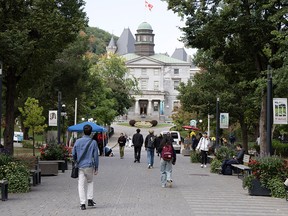Tough talk needed on border issues
“Lay low for 14 days and you’re in as an illegal”
- National Post
- 14 Nov 2024
- JAMIE SARKONAK

Currently, as the rules stand, migrants from the United States can cross into Canada, wait two weeks, and become eligible to file a refugee claim here. The northern border sure must be looking like a home-free line, now that Donald Trump has been elected on a promise to carry out mass deportations of illegal migrants.
So, if there was ever a time Canada needed to send a very loud, very public, “no more Mr. Nice Guy” message to economically motivated asylum seekers — firm messaging backed up by policy changes to ward their numbers off — it’s right now.
The numbers are already too high. Last year, nearly 150,000 people staked refugee claims here, rendering us the fifth-largest destination for asylum seekers that year. Two years’ worth of asylum claims are inching their way through the immigration system, many of these from friendly not-at-war countries that have no business sending us thousands of refugees.
India, Nigeria, and Mexico are where the largest number of claims come from, but there are many others that shouldn’t be sending refugees our way. Each successful applicant — from friendly, at-peace countries — is a potential online advertisement for immigration services online; that is, potential inspiration for others looking to claim refugee status. Of course, many of these claimants aren’t actually in danger, as required by law, and are willing to travel home, prompting immigration consultants to make warnings against doing so.
With the threat of mass deportations from the U.S., and a policy in Canada that allows unauthorized residents to claim asylum should they lay low for 14 days, it’s only rational for would-be claimants to try. It could very well be a painful squeeze — the U.S. received 1.2 million asylum claims last year alone, and some fraction of that number can be expected to divert to the north come 2025.
The trek to Canada will be a rational one for many. To observers on the outside, we’re the country that welcomes everyone, hands out bags of free food, offers free care, has loads of jobs to fill along with land, oh so much land. We know this isn’t actually how Canada works, but they don’t.
Seriously. Extensive immigration influencer videos have advertised Canadian “free food” to those abroad, which have no doubt made this country a more attractive place to attempt asylum. Rent is often covered by the Canadian tax base as the wait for claim adjudication drags on — which ultimately puts low-income Canadians in competition with migrants for housing. Some also end up competing with homeless Canadians, taking up critical space in shelters from Vancouver to Toronto.
MANY OF THESE CLAIMANTS AREN’T ACTUALLY IN DANGER.
In health care, it’s a similar problem. These populations strain the health-care system: the Star reported last week that “Midwives and physicians in emergency departments said they’re seeing significantly more uninsured clients accessing care at later stages of a complicated pregnancy or an already developed cancer or AIDS.” The uninsured being, in part, migrants who are in Canada illegally. Bad deal for us, good deal for them.
Between rosy influencer advertising and borders-open messaging from our own Prime Minister Justin Trudeau, a lot more needs to be done to reverse the perception that Canada is a welcome home for economic “refugees.”
The incoming Trump administration has been strong out of the gate in turning around the perception of the United States as a bottomless bread basket of free amenities. Federal and state governments have rolled out unauthorized-friendly initiatives for a while now: feds have done their best to soften deportation rules, and some state governments have offered perks like pre-paid debit cards for migrants, as well as free rent. But Trump’s messaging has been clear that deportations are coming, and his border-enforcer-to-be, Tom Homan, is just as forceful: “You better start packing now, cause you’re going home,” Homan told a crowd earlier this year.
We haven’t been so firm. Visitor visa rules were tightened this week, but the home-free-in-twoweeks line remains in place.
Most of our country’s messaging includes tepid inward-facing assurances that everything is under control. The faceless blob that is the Canadian administrative state says there’s nothing to worry about: the RCMP learned from post-2016 migration which “provided us with the tools and insight necessary to address similar types of occurrences.” The Canada Border Services Agency (CBSA) says, “we are ready to respond and adapt as needed.”
Homan, meanwhile, isn’t raving about our competency, stating in a recent TV interview that the northern border is an “extreme national security vulnerability” and that “tough conversations” are soon to be had with Canada.
Meanwhile, Immigration Minister Marc Miller is nonchalant, telling the Globe and Mail: “We will always be acting in the national interest and those measures that we move to undertake, regardless of what decision is taken by the new administration, to make sure that our borders are secure, that people that are coming to Canada do so in a regular pathway, and the reality that not everyone is welcome here.”
Well, that sure sends a message. “Not everyone is welcome here.”
Each statement from Canadian officials has the same bland, inoffensive lack of substance that could only come from either a comms department trained to generate few words of meaning or an AI text generator. None are backed by the force of strong, loophole-closing policy change.
Miller’s job right now isn’t just to soothe Canadians with words as bland as beige walls. He has to dispel years of false impressions of Canadian life inspired by a multitude of enthusiastic foreign-language Youtube and Tiktok howto vlogs about immigration, with rhetoric and hard policy. Right now, he’s falling short.

